Have you ever found yourself staring at a blank screen, struggling to find the right words to create a captivating blog post?
As bloggers and marketers, we understand the challenges of consistently delivering high-quality content while ensuring it ranks well in search engines.
That’s where our game-changing solution comes in.
We have curated 9 must-have SEO blog post templates designed to accelerate your content creation process.
We are sharing examples for each SEO blog template.
These SEO blog templates and examples simplify brainstorming and research, allowing for quicker and easier SEO copywriting.
Finally, we will also share an amazing SEO content tool to help you create any SEO blog post template.
Let’s take a look at the most popular and effective blog post templates.
Table of Contents
1. Listicle Blog Post Template
What is a Listicle Blog Post?
Listicle articles have become a popular and engaging format for presenting information to readers.
They take on a straightforward structure, offering content in the form of a list. From “10 Ways to Boost Productivity” to “5 Tips for Better Time Management,” listicles provide valuable insights in a digestible and easy-to-read manner.
At thruuu, we appreciate this format as it drives traffic and also conversion.
As you can see, one of our listicle blog posts is climbing the SERP week after week.
If you search for “free content writing tools” you might find us at the top of Google.
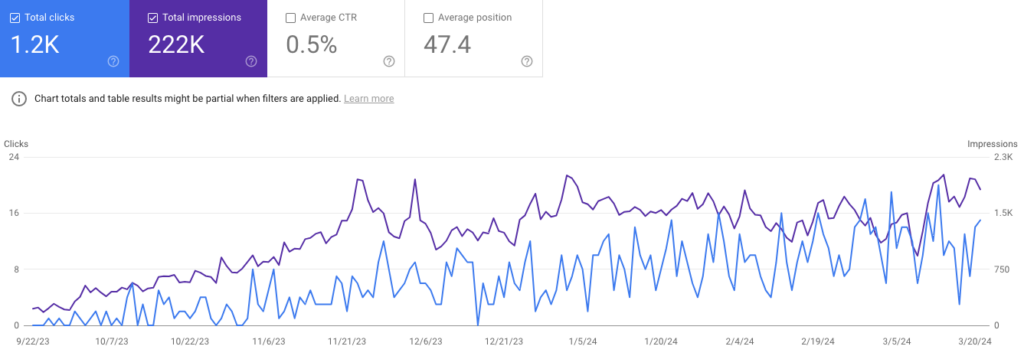
Let’s dive into some details about a listicle blog post. We’ll explore its format, key benefits, and how you can create it.
Key Benefits
- Easy to read and understand
- Engaging to read
- Easy to share, promote, and repurpose
- Drive conversion
How to Create a Listicle Blog Post
Listicle articles are a popular format for engaging readers and presenting information in a concise and skimmable manner.
Here are some steps to get started:
Crafting the Title
The title of your listicle blog plays a crucial role in attracting readers and setting the tone for your content. To create an effective title:
1. Be Specific and Descriptive: Clearly indicate what the listicle is about and what readers can expect to find in it. For example, “10 Productivity Hacks to Skyrocket Your Efficiency.”
2. Use Numbers: Incorporate a specific number in your title, such as “5 Tips,” “7 Strategies,” or “15 Must-Have Tools.”
🔥 Pro Tip: When writing a listicle blog post about tools or SaaS products, include a differentiator in your title, such as “Free“, “Best” or “Cost-effective“.
Outline Structure
Here’s a listicle sample outline structure titled “7 Healthy Foods for Busy Professionals”:
Introduction
Choose a short intro over a long one. People search for lists to get instant gratification. They don’t have time to sift through a sea of text.
Also, include the main keywords from your keyword research here; however, it should appear natural.
Body
The structure should be simple: each new item = subheading.
However, here you need to maintain consistency across all the points. For example, you can provide a short overview of each item first and then proceed to the details.
- H2: Optional subheading needed to develop a topic
- H2: Item 1 (overview + details)
- H2: Item 2 (overview + details)
- H2: Item 3 (overview + details)
- Conclusion
Make sure to include your closing remarks. You can answer the question you asked in the title or intro.
Best Practices
To create a compelling listicle blog, consider incorporating these best practices:
Visual Appeal: Incorporate images or graphics that complement each point and break up the text. Visual elements make the content more engaging and appealing to readers.
Conciseness and Clarity: Keep each point brief and to the point. Aim to deliver valuable information succinctly, so readers can easily grasp the main ideas.
Include Actionable Tips: Ensure that each point offers practical and actionable tips that readers can implement daily.
Add Value: Go beyond the surface level and provide unique insights or lesser-known facts to make your listicle stand out.
Examples of Listicle Blog Posts
Below find great examples of a listicle blog posts.

- 6 Secrets to Achieving Work-Life Balance
- Soups To Make Every Month Of 2023
- The Best Super Bowl Commercials of 2023
- Best SEO Tools for Your B2B SaaS and Startup
- Top 13 Free Content Optimization Tools
Tool to create a Listicle Blog Post Template
thruuu can save you hours by generating a content outline for you. Its content brief generator and AI-based solution can generate outlines for you by analyzing the Google SERP.
You can define the format of your outline and choose the listicle template. Here is how it works:
- Open the content brief generator
- Enter your target keyword and how your audience will search for the content
- Jump to the outline generator and hit the “Generate” button
- Select “From the competitor heading” and select the “Listicle” format
- Press Generate
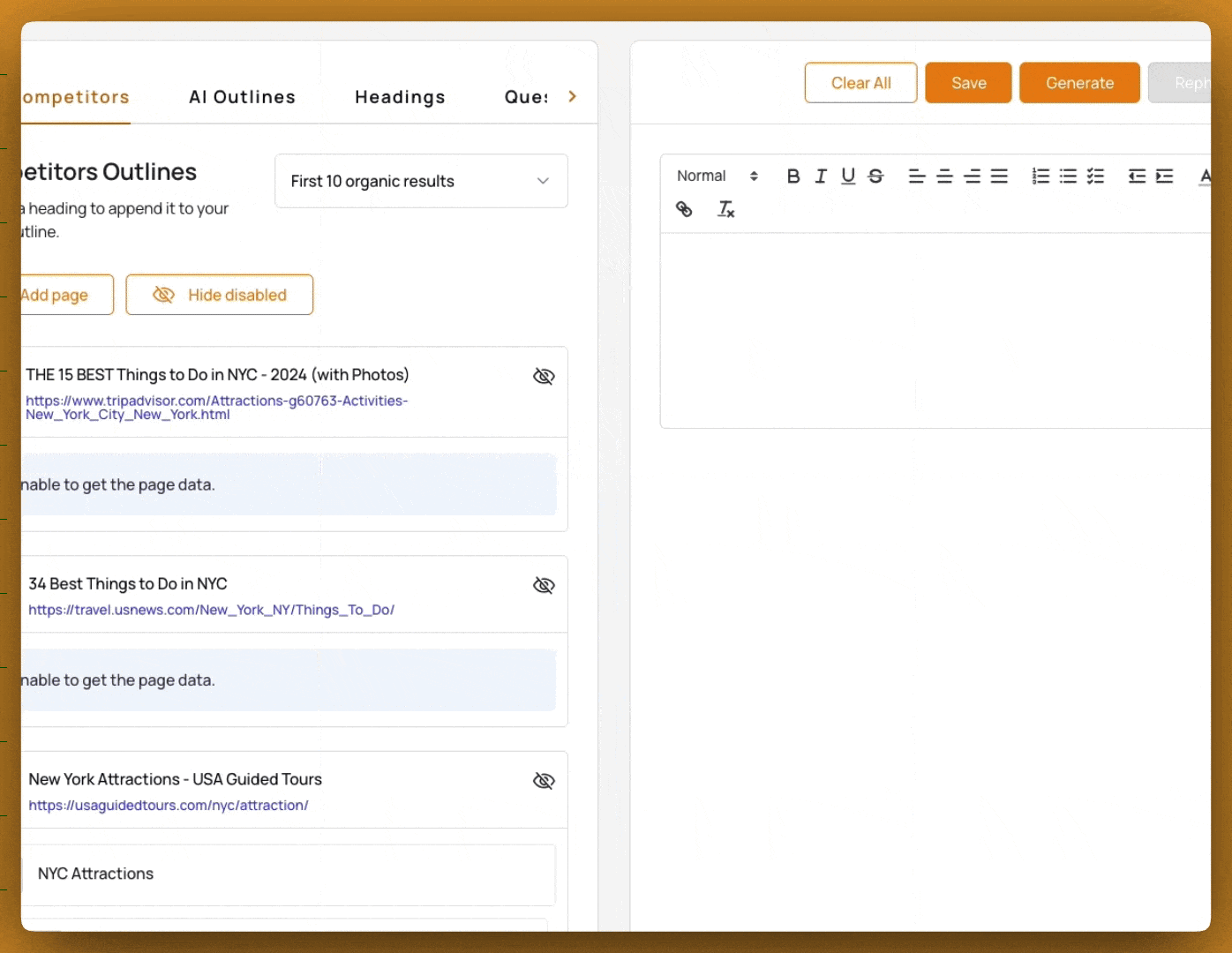
After generating the outline, it is recommended to review competitor headings to identify any gaps in your content structure or discover new ideas.
You can watch me create a listicle and product review in the following video using the thruuu content brief generators.
👉 Learn more about how to create content briefs with thruuu.
2. Tips Blog Post Template
What is a Tips Blog Post?
If you’re looking for a way to deliver valuable insights without overwhelming your readers, a Tips blog post is a great way to do that.
You can add a tips section to almost any blog post, but for some topics, “[topic name] tips” is often a title itself.
Tips articles are structured around a list of tips. For example, “Tip 1: [Description of Tip 1],” “Tip 2: [Description of Tip 2],” and so on. In such cases, you use Heading 2 for each tip.
Key Benefits
- Easy to read and understand quickly
- Addictive to read
- Easy to promote and share
How to Create a Tips Blog Post
If you’re interested in starting a tips blog post that resonates with your audience and provides value, here are some essential steps to consider:
Crafting the Title
The title of your tips blog post should be clear, specific, and attention-grabbing.
Make sure to use relevant keywords to optimize for search engines and attract your target audience. For example, “10 Time-Saving Tips for Busy Professionals” or “5 Healthy Eating Tips for Beginners.”
Outline Structure
Organize your tips blog with a logical and reader-friendly structure.
Each tip should be given a heading (for example, “Tip #1” or “Strategy #3”) to make navigation a lot easier.
Here’s a sample outline for a tips blog post on “Effective Study Tips”:
- Title: [Topic]: X Tips to [Achieve Result] // X [Topic] Tips to [Achieve Result]
- Intro: A few sentences (120 words or less) with three bullets on what they’ll get out of the post.
- H2 Introducing topic (Optional)
- H2 providing prerequisite information (Optional)
- X tips to [value here]
- Tip
- Tip
- Tip
- Tip
- Use these tips to [achieve X]
Best Practices
To optimize the impact of your tips blog post, consider implementing the following best practices:
Provide Actionable Tips: Ensure that each tip offers actionable steps or strategies that readers can easily implement in their daily lives.
Include Relevant Examples: Illustrate the tips with real-life examples or scenarios to make them more relatable and understandable.
At thruuu, we like to include testimonials from industry experts in our tips blog post. One of our strategies is to leverage UGC (User Generated Content) by including comments from experts found on social media.
Check this article about “15 Expert Tips to Create Content Outlines” and you will notice the inclusion of expert quotes and feedback.
UGC and SEO is a proven tactic to bring unique angles to your article.
Use Visually Engaging Elements: Incorporate images, graphics, or icons to enhance the visual appeal of your tips blog and make it more inviting to readers.
Examples of Tips Blog Posts
Below, find examples of tips blog posts.

- 7 Email Copywriting Tips We Swear By (With Examples!)
- 25 Scientifically Proven Tips for More Effective Studying
- 11 Workout Tips to Make Your Exercises More Effective
- 5 Tips to Get Content Ideas with Google Search Console
Tool to Create a Tips Blog Post Template
The thruuu content outline generator allows you to customize the format of your article.
For a tips blog, simply follow the previously explained steps and choose the “Tips” format to create its structure.
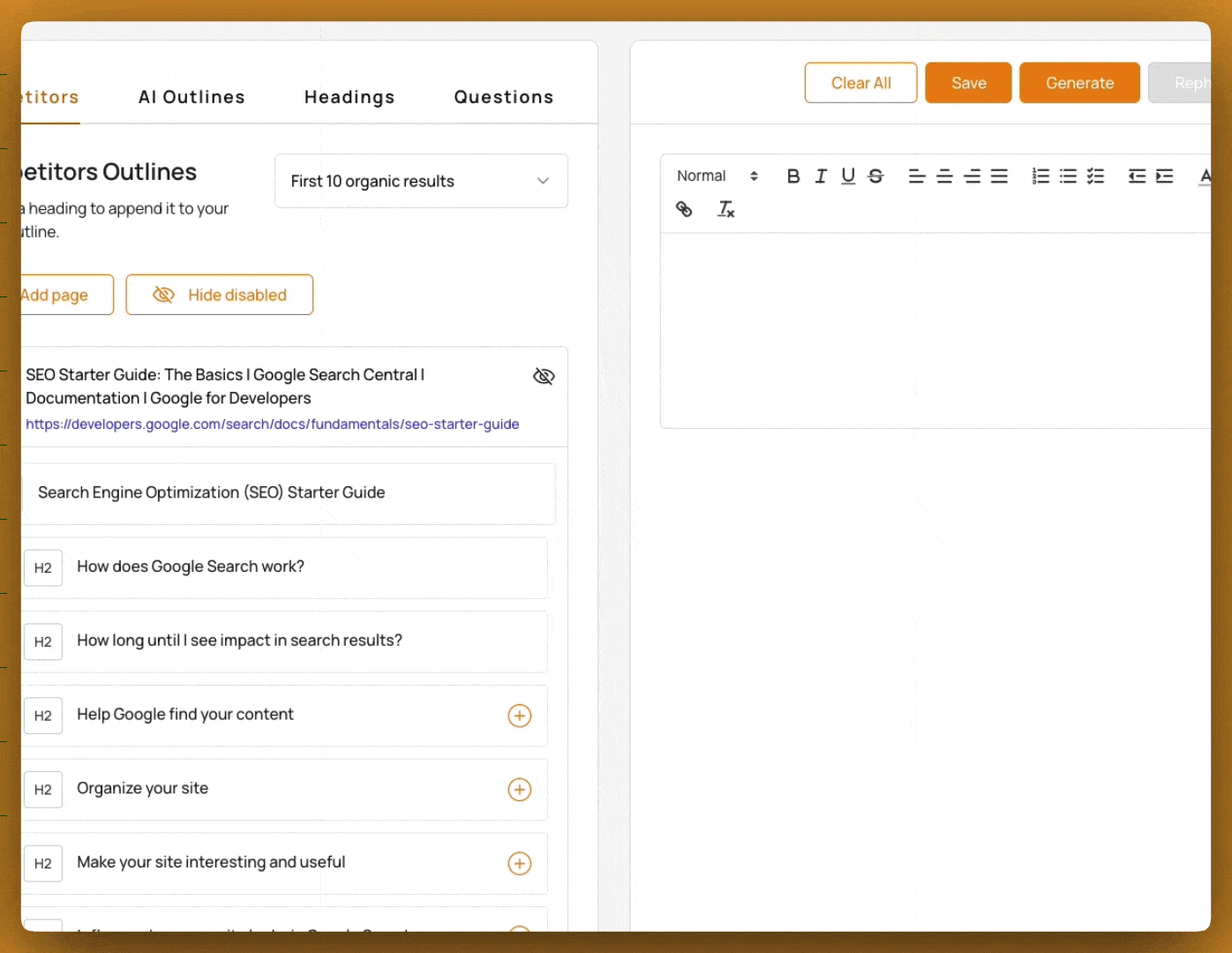
3. How-To Blog Post Template
What is a How-to Blog Post?
The How-to format is designed to guide readers through a process by offering them clear and concise directions.
For example, “How to Start a Blog” or “How to Use a Content Outline Tool.” Heading 2 is usually used when outlining the steps.
Key Benefits
- Practical guidance
- Clear structure
- Visual learning
How to Create a How-to Blog Post
Follow these steps to create a How-to Blog:
Crafting the Title
The title of your How-to guide blog plays an important role in attracting readers and indicating the purpose of the content. To create an effective title:
1. Specify the Task: Clearly state what the blog will teach readers how to do. For example, “How to Paint a Watercolor Landscape” or “How to Build a DIY Bookshelf.”
2. Highlight the Benefit: Explain why readers should follow the instructions, such as “Achieve Professional-Looking Paintings” or “Organize Your Home with Custom Furniture.”
Outline Structure
Here’s a sample outline structure:
- Title: How to X in X Steps or [Topic]: X Steps to [Achieve Result]
- Intro: A few sentences (120 words or less) with three bullets on what they’ll get out of the post.
Steps overview
- X steps to [achieve result]
- Alternatively, you could make each step an H2.
- Step 1
- Step 2
- Step 3
- Optional H2 on next steps/expectations
- Start [achieving result] now
Best Practices
To create a great How-to blog, consider making use of these best practices:
Clarity and Simplicity: Use clear and concise language, and break down complex tasks into manageable steps.
Visual Aids: Include images, diagrams, or videos to illustrate each step and enhance understanding.
Actionable Steps: Ensure that each step provides actionable instructions that readers can follow.
Examples of How-to Blog Post
Below find examples of How-to blog post

- How to Brand Your Business in 7 Steps
- How to Install WordPress the RIGHT WAY
- How to Build a Brand: An 8-Step Guide for 2023
Tool to Create a How-to Blog Post Template
thruuu offers great features to help you craft the perfect How-to blog.
As mentioned previously, you can automatically generate a How-to blog outline structure by selecting the right format.
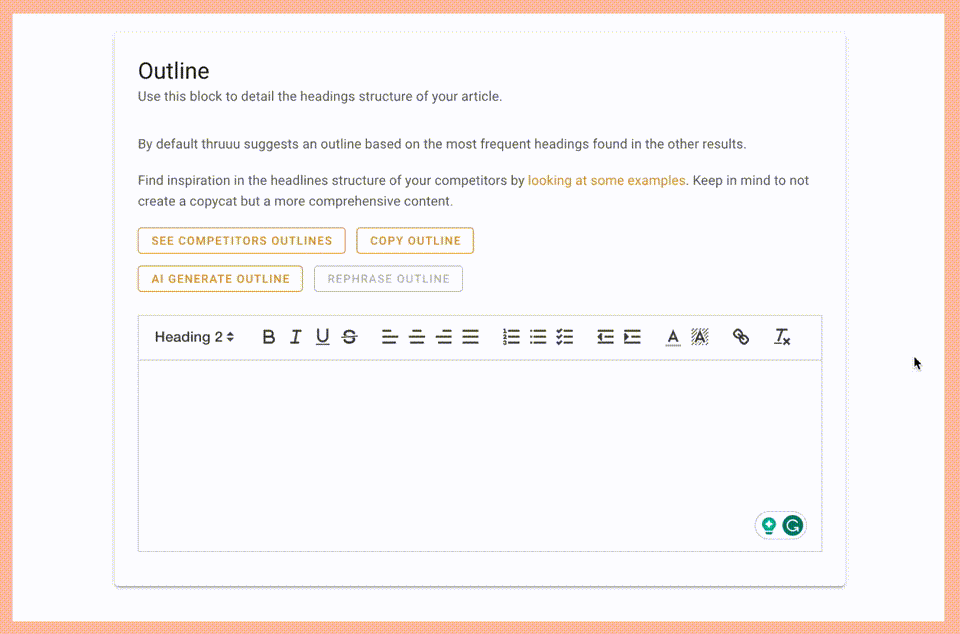
In addition, the SERP Analysis tool provides valuable insights into the SERP.
It reveals the most common questions addressed by your competitors, which can aid in organizing your article and incorporating pertinent topics into your headings.
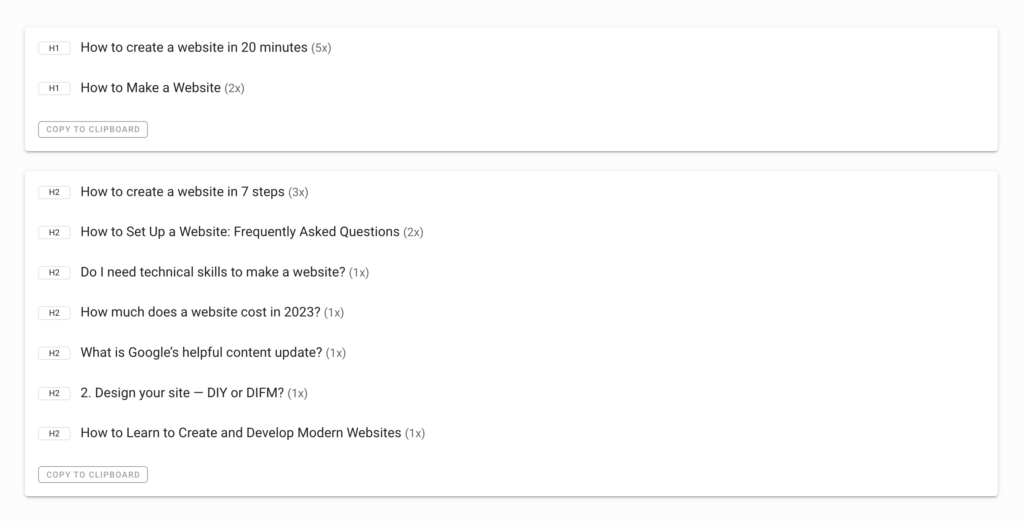
4. Case Study Blog Post Template
What is a Case Study Blog Post?
Case study blog post are great tools that showcase real-world examples and success stories to demonstrate the effectiveness of products, services, or strategies.
Unlike listicles or tips blogs, case studies provide a more in-depth analysis and leverage user-generated content for SEO.
Case studies usually focus on a particular client, project, or situation, intending to educate readers on how others have overcome obstacles and achieved their goals. For example, “How Company X Scaled from Zero to 100 Locations with the Help of Company Y”.
Key Benefits
- In-depth insight
- Real-life application
- Demonstrating expertise
How to Create a Case Study Blog Post
Here are some steps to follow when creating a case study blog post:
Crafting the Title
Here is how you can create an effective case study blog post title:
1. Description: Let the readers know what they can expect to learn from your case study blog. For example, “How XYZ Company Increased Website Conversions by 200% in 3 Months”.
2. Key Elements: Mention something relevant to the study. It could be the strategies used or the outcomes achieved. For example, “Transforming Customer Experience: A Retail Case Study.”
Outline Structure
Here’s a sample outline structure for a case study:
- Introduction: Provide an overview of the case study subject
- Study Background: Give a context to your current study, citing past related work
- Strategies Implemented by the Company: Detail the mode of operation the company used to carry out its study
- Results and Outcomes: Give a run down of what the study results were.
- Lessons Learned: Give a concise and helpful takeaway from the overall study.
- Conclusion: Summarize the overall impact of the strategies on employee satisfaction.
Best Practices
To create a compelling case study blog post, consider these best practices:
Visual Elements: Images and charts are a great way to make the blog look better and aid comprehension.
Credible Sources: Include reliable data from credible sources.
Readability: Use clear and concise language that your readers can easily understand.
Examples of Case Study Blog Posts

- The Whole Package
- Chevrolet DTU
- How Fractl Earned Links from 931 Unique Domains for Porch.com in a Single Year
Tool to Create a Case Study Blog Post Template
With the thruuu SEO outline tool, you can as well pick the Case Study format. It will help you get started with a proper structure.
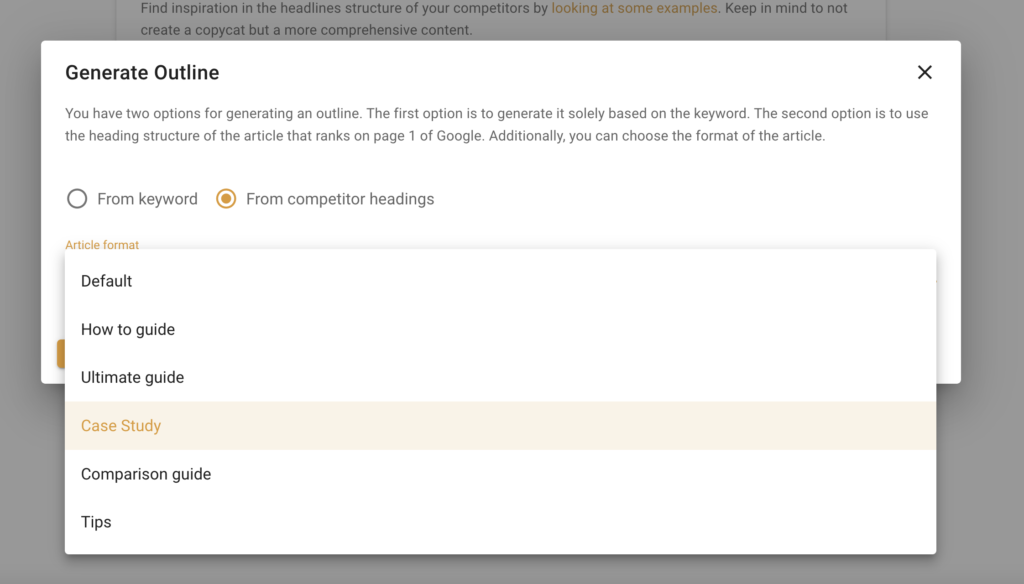
When creating a Case Study blog, it’s important to gather unique information from your customers.
The most effective way to do this is by conducting a survey. Utilizing tools like Google Forms, you can send a list of questions about a successful project to gather sufficient information for your article.
5. Ultimate Guide Blog Post Template
What is an Ultimate Guide Blog Post?
An ultimate guide blog post is a comprehensive article that provides in-depth information and expertise on a particular topic.
Unlike regular blog posts that cover specific aspects, the ultimate guide blog works well for readers who want complete knowledge on the subject.
It answers the questions of what, why, and how. It also shares steps, examples, and more information.
Heading 2 should be used for each section or subtopic within the guide.
Ultimate guides often finish with a FAQ section listing the most frequently asked questions.
For example, “The Ultimate Guide to Digital Marketing” or “A Comprehensive Guide to Healthy Eating.” These blogs offer valuable insights, step-by-step instructions, and practical tips.
Key Benefits
- Comprehensive information
- Step-by-step instructions
- Single point of reference
How to Create an Ultimate Guide Blog Post
Use these as a template to create your Ultimate Guide Blog:
Crafting the Title
To create an effective title:
1. Be Specific: Clearly state the topic of the guide and what readers can expect to find in it.
2. Include Key Subtopics: Mention the key areas or subtopics that the guide will cover. For example, “The Ultimate Guide to Mastering Content Marketing.”
Outline Structure
- Title: The Complete Guide to [Topic]
Intro: Introductory sentences (120 words or less) with three bullets on what they’ll get out of the post.
- What is X
- Why is X important?
- Types of X or How X works
- How to do X
- Step
- Step
- Step
- Tips & best practices for successful X
- Tip
- Tip
- Tip
- Tools for X
- Tool
- Tool
- Tool
- Get started with X today
- FAQs
Best Practices
To create a compelling ultimate guide blog, consider incorporating these best practices:
Visual Elements: Engage your readers better by including relevant images.
Detailed Research: Ensure that your guide is well-researched.
Clear Structure: Make it easy for readers to read through by organizing headings and subheadings well.
Examples of Ultimate Guide Blog Posts
Below find examples of Ultimate Guide Blog Post
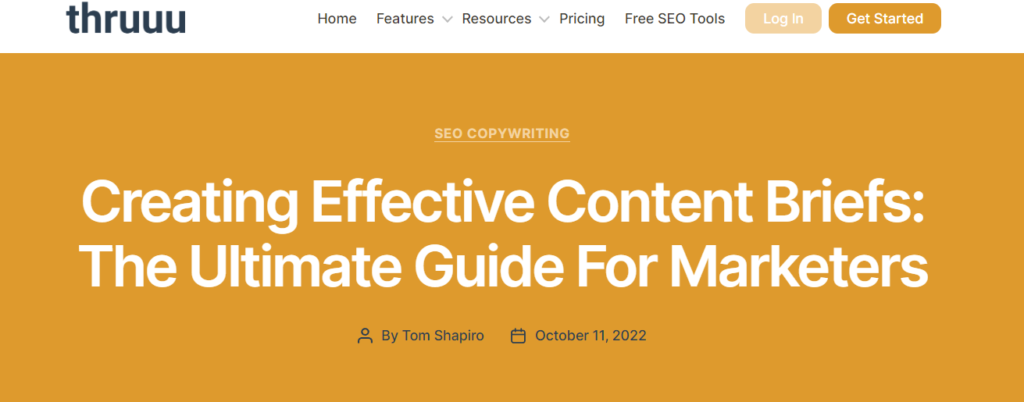
- The Ultimate Guide to Communication
- Email Marketing: The Ultimate Guide (+ Expert Tips)
- Creating Effective Content Briefs: The Ultimate Guide For Marketers
Tool to Create an Ultimate Guide Blog Post
With thruuu end-to-end SEO content solution for content teams, you have a set of tools to help you create compelling ultimate guides.
The content brief generator will help you craft the perfect blog structure.
To get started, use the article outline tool with the “Ultimate guide” format.
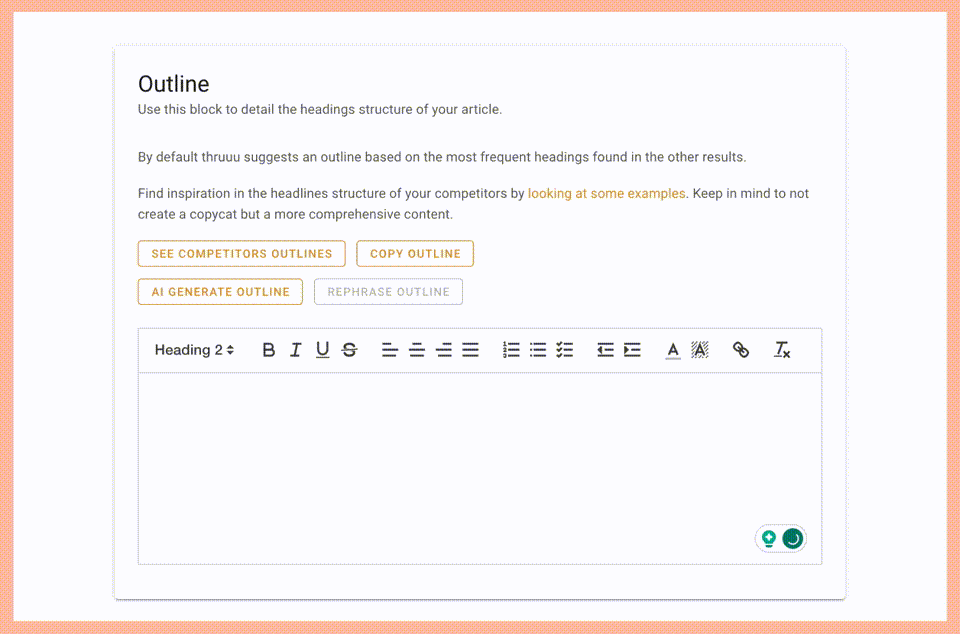
Ultimate guides must be more than complete. Browse your competitors’ heading and collect any missing information.
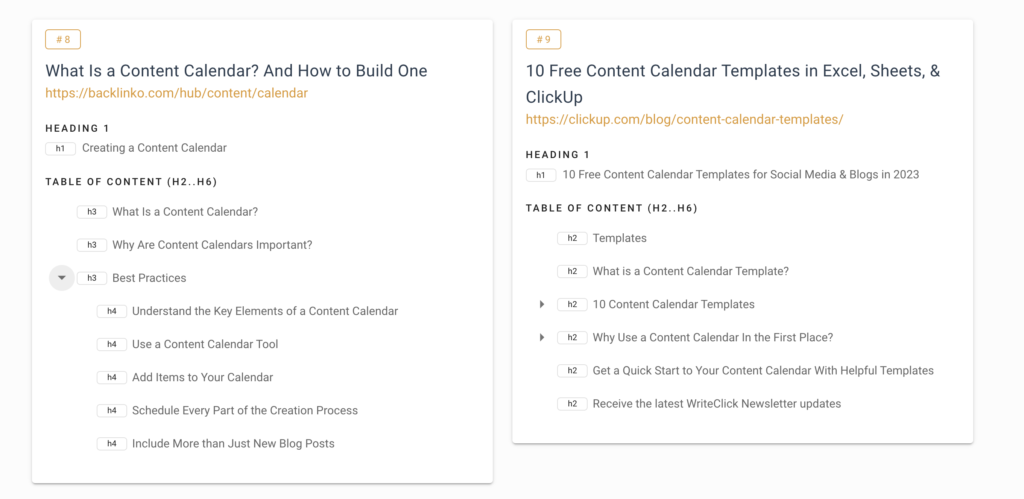
It would be helpful to review the frequently asked questions (FAQs) used by your competitors. This can help you create your own FAQ section.
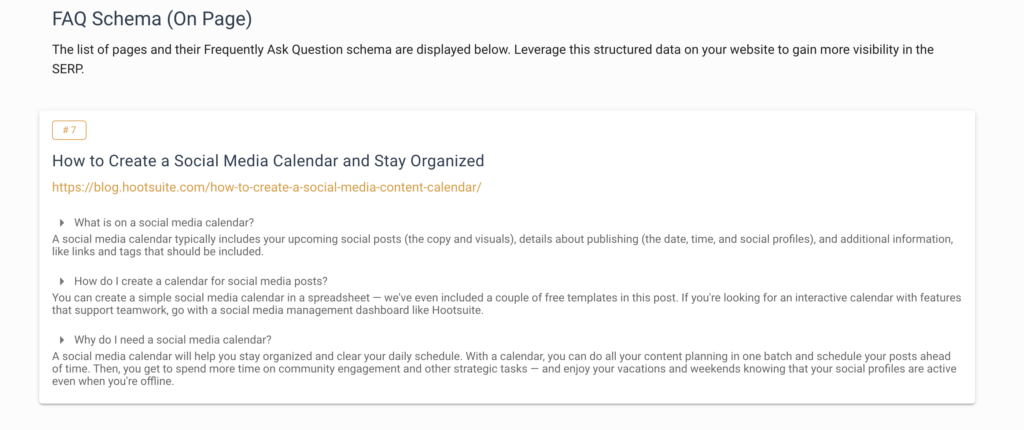
By conducting a SERP analysis, you can identify the most commonly used keywords and topics.
This information can assist you in determining if your article is comprehensive or if there are any gaps.
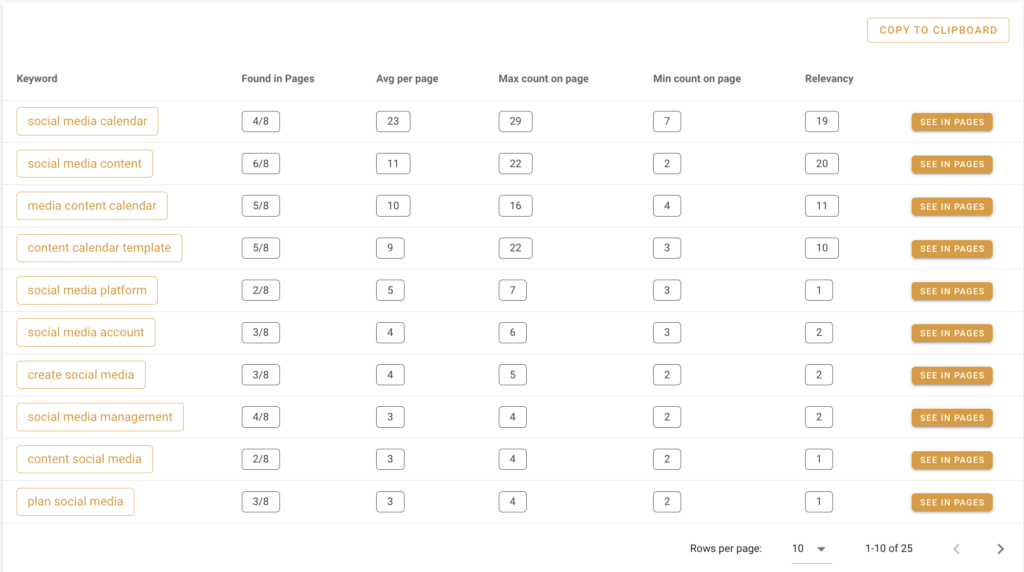
Write Better Content Briefs. Faster.
With the thruuu Content Brief Generator, reduce your research time by 90% and compile data from the SERP in a user-friendly interface.
6. Product Review Blog Post Template
What is a Product Review Blog Post?
A product review blog post is a specialized platform where authors provide in-depth assessments and evaluations of various products, services, professional tools, SaaS or gadgets.
These blog post templates offer valuable insights into the features, pros, and cons of different items to help readers make informed purchasing decisions.
They could do this in the form of featured snippets about certain aspects or go into full detail.
Whether it’s “The Ultimate Smartphone Review” or “A Comprehensive Analysis of Fitness Trackers,” product review blogs aim to guide consumers toward the best options available in the market.
Key Benefits
- Objective evaluations
- Informed decision-making
- Consumer empowerment
How to Create a Product Review Blog Post
Here are some steps to help create a product review blog:
Crafting the Title
Here’s how to title your Product Review blog so that it attracts readers and sets expectations for the content:
1. Specify the Product Type: Clearly state the category or type of product being reviewed.
2. Highlight the Review Approach: Indicate the type of review. It could be a comparative review, a list of top-rated products, or an analysis of a particular product.
3. Include Key Selling Points: Mention unique selling points or features that will grab readers’ attention. For example, “The Best Smartwatches of 2023” or “Top Gaming Laptops for Performance and Portability.”
Outline Structure
Here’s a sample outline structure for a Product Review blog titled:
- Introduction: (Quick) overview of what your post is all about.
- Mention which product features you’re going to evaluate.
- Encourage people to read the entire review.
- Product Overview Section: Overview of each product.
- Feature-By-Feature Comparison
- Product Review Conclusion
Best Practices
To create an impactful product review blog, consider implementing these best practices:
Real-world Testing: Conduct hands-on testing of the products to provide practical insights.
Balance Pros and Cons: Offer a balanced view of each product.
User Feedback: Consider including feedback from actual users or customers in your review.
Examples of Product Review Blog Posts
Below, find examples of Product Review Blog Posts.

- Garmin Fenix 7S Pro review: too much of the same
- The Best Wireless and Wired Headsets
- MailChimp Review (2023)
Tool to Create a Product Review Blog Post Template
The Content Brief Generator by thruuu can help you create a well-structured product review.
Here is an outline automatically generated for the keyword “best TV 2023”.
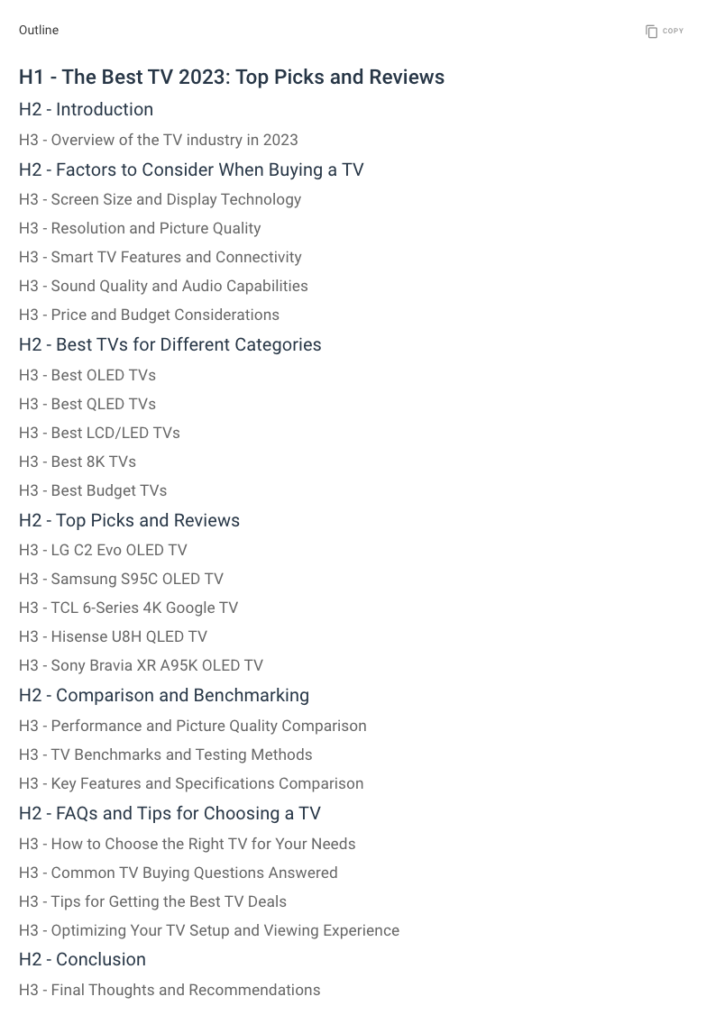
As you can see, the outline contains the most frequent TV categories and best TV in 2023.
To provide a more detailed product review, you may want to check out the competitor’s headings and incorporate any additional information into the existing structure.
With the thruuu outline tool, you can easily pick the best headings and add them to your outline.
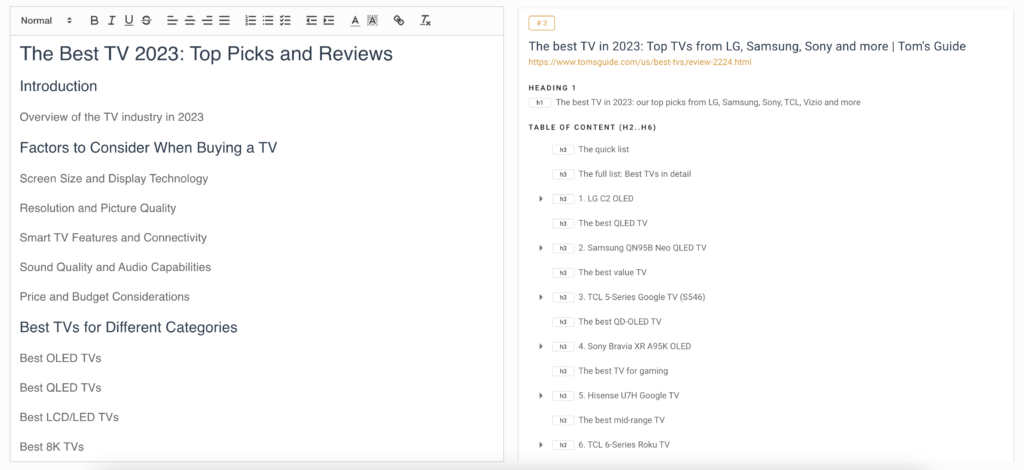
7. Product Alternative Blog Post Template
What is a Product Alternative Blog Post?
A product alternative blog post helps readers discover alternative products or solutions to popular or well-known items.
It provides insights into various products or services that serve similar purposes. This gives the readers more options to consider.
For example, “Budget-Friendly Alternatives to High-End Smartphones.” This blog helps readers to explore choices that suit their preferences, budgets, or values.
Key Benefits
- Diverse options
- Cost-effectiveness
- Customization
How to Create a Product Alternative Blog Post
Here are some steps you can take to create a Product Alternative Blog:
Crafting the Title
1. Identify the Product Category: Clearly state the type or category of the product you’re providing alternatives for. For example, “Top Alternatives to [Popular Product]” or “Budget-Friendly Options for [Product Category].
2. Highlight Unique Selling Points: Use words such as “Eco-Friendly,” “Durable,” or “Feature-Rich.”
Outline Structure
Here’s a template for a Product Alternative blog post:
- Introduction: Explain the popularity of the product and the need for alternative options.
- Address the benefits of exploring alternative products.
- Product Alternative 1:
- Pros and Cons
- Product Option 2:
- Pros and Cons
- Product Option 3:
- Pros and Cons
- Conclusion: Go over the significance of exploring alternative products again as a recap.
Best Practices
To create a compelling Product Alternative blog post, consider some of these best practices:
- Reader-Centric Approach: Keep the focus on the reader’s needs and preferences.
- Research: Make sure to research and test each alternative product so you can provide accurate and insightful information.
- Direct Comparisons: Directly compare each alternative.
Examples of Product Alternative blog posts
Below find examples of Product Alternative blog posts.

- Best Superblog Alternatives
- 8 Best Blogger Alternatives
- 7 Amazing Shampoo Alternatives You Should Consider in 2023
Tool to Create a Product Alternative Blog Post Template
Using the thruuu Content Brief Generator, you can easily create a comprehensive outline for a Product Alternative blog post.
By conducting a SERP analysis, the tool will gather important details from your competitors and provide a list of the top product alternatives.
In the example below, we simply entered the keyword “Mailchimp alternative” and let the tool defines the best structure.
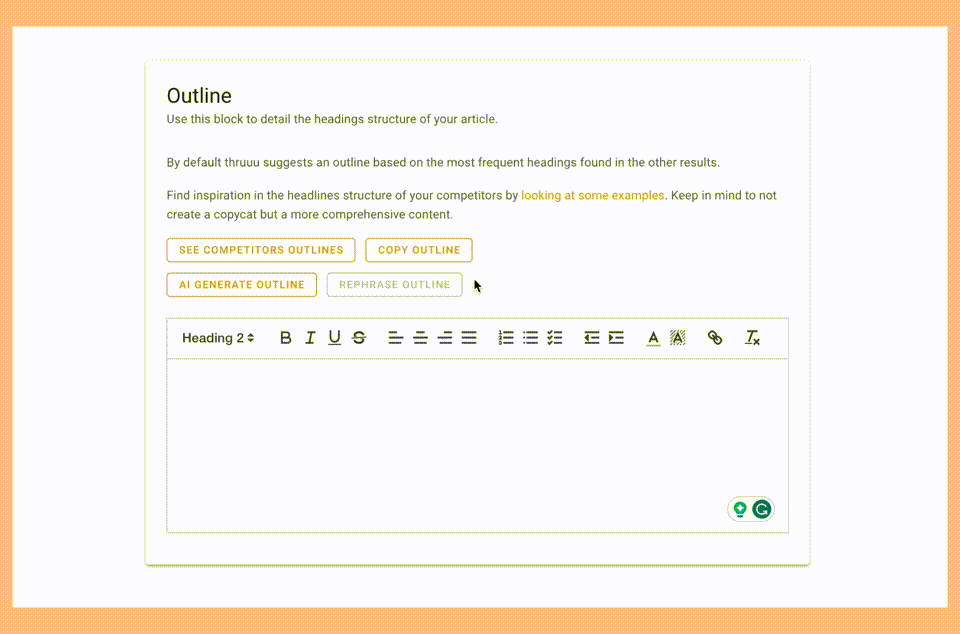
8. Comparison Guide Blog Post Template
What is a Comparison Guide Blog Post?
A comparison guide blog post helps readers make informed decisions by comparing different products, services, or options within a specific category.
It compares and contrasts two or more options, enabling readers to evaluate which one aligns best with their goals.
For example, “Comparison Guide: Best Laptops for Students”, and “Headphone Showdown: Sony vs. Bose vs. Sennheiser.” These blogs provide valuable insights for readers who need some help in making a well-informed choice.
Key Benefits
- Informed decision-making
- Clear understanding
- Impartial analysis
How to Create a Comparison Guide Blog Post
If you’re interested in creating a comparison guide blog post that helps readers make well-informed decisions, follow these steps:
Crafting the Title
The title of your comparison guide blog plays a crucial role in attracting readers and indicating the purpose of the content. To create an effective title:
1. Specify the Product or Service Category: Clearly state the type or category of products or services you are comparing. For example, “Comparison Guide: Top Smartphones for Photography” or “Web Hosting Services Showdown: Bluehost vs. SiteGround vs. HostGator.”
2. Highlight Key Criteria: Mention the specific features or criteria you plan to address in the comparison, such as “Performance,” “Price,” or “Customer Support.”
Outline Structure
Here’s a template for a Comparison Guide blog post:
- Feature 1
- Subject A Details
- Subject B Details
- Feature 2
- Subject A Details
- Subject B Details
- Feature 3
- Subject A Details
- Subject B Details
In this case, the article emphasizes the features over the actual subjects. As a result, the reader gets a more direct side-by-side comparison.
Best Practices
To create an impactful Comparison Guide blog post, consider incorporating these best practices:
- Thorough Research: Conduct in-depth research on each product or service to provide accurate and up-to-date information.
- Neutral Tone: Your readers will tend to trust you more if you maintain an objective tone throughout the comparison.
- Visual Aid: Use charts, tables, or infographics to present the comparison data in a visually appealing and understandable manner.
Examples of Comparison Guide Blog Posts
Below examples of comparison guide blog posts.

- Blogger vs. WordPress: Which Should You Use?
- ConvertKit vs AWeber vs MailChimp: The Best Email Marketing Tools for Bloggers
- Nikon D5600 vs D7500: Which Should You Buy? – Light And Matter
Tool to Create a Product Comparison Blog Post Template
thruuu is an excellent tool for organizing a Product Comparison blog. To use the outline generator effectively, enter the names of the two products you wish to compare as a seed term.
By analyzing the SERP, thruuu will extract the primary features to compare.
Below is the outline generated for the comparison of Ahref vs SEMRush.
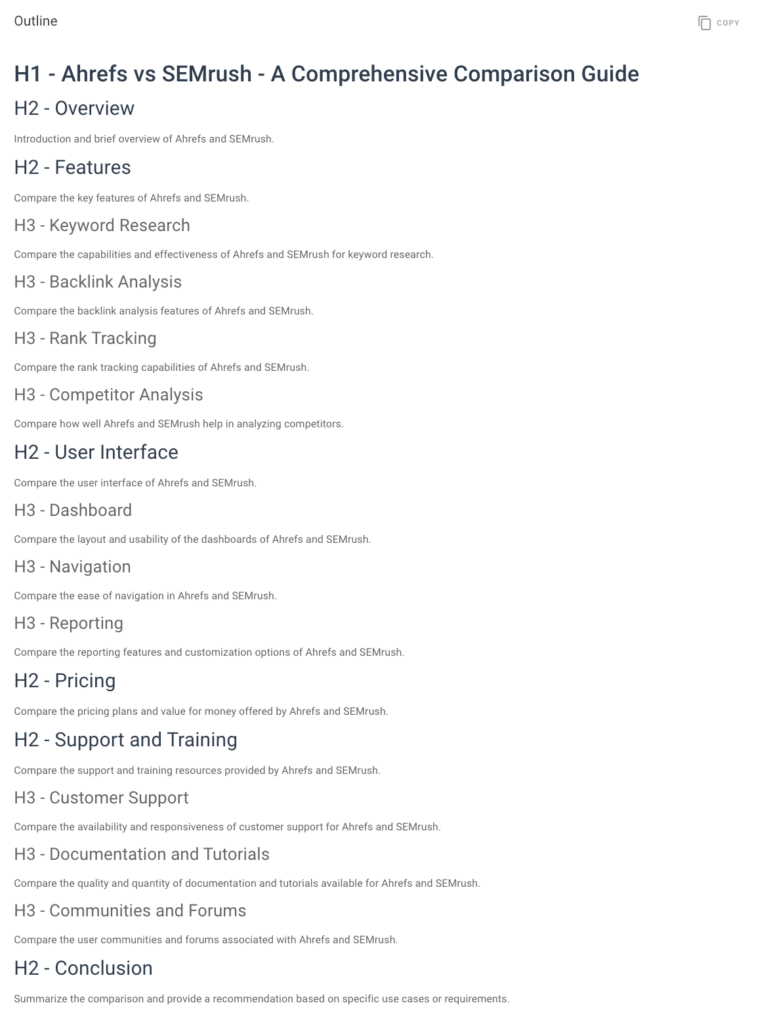
9. FAQ Blog Post Template
What is a FAQ Blog Post Template?
A FAQ Blog Post is a blog post structured around questions and answers.
At thruuu, we are big fan of this top-of-the-funnel (TOFU) content as it let us educate our audience and are also easy to create.
We wrote a dedicated article about FAQ Blog Post if you want to have more information.
Key Benefits
- Easy to create
- Excellent TOFU Content to educate your audience
- Can serve as pillar page
How to Create a FAQ Blog Post
If you’re interested in creating a FAQ blog post that educate your audience, follow these steps:
Crafting the Title
The title of a FAQ Blog Post could be a question and include your main topic.
FAQ blog post titles can follow this pattern “What is [your topic]?”.
Alternatively, you can also use the following title formats:
- All you Want to Know about [your topic]
- Most Frequent Questions about [your topic]
- Top XX Questions about [your topic]
Outline Structure
Here’s a sample outline structure for a FAQ Blog Post:
- What is X
- Why is X important?
- How. to make X
- Add as many questions as you want…
We recommend using a Heading 2 (H2) for each question.
Best Practices
To create detailed FAQ blog post, consider incorporating these best practices:
One Question, One Heading: Make your blog post easy to ready and highlight each question in a heading.
Provide clear and straight answers: Answer the question in one or two paragraphs right after the heading. Then, you can develop further if needed.
Leverage internal linking: Link each question to a more detailed article within your blog.
Examples of FAQ Blog Posts
Below find examples of FAQ Blog Post.
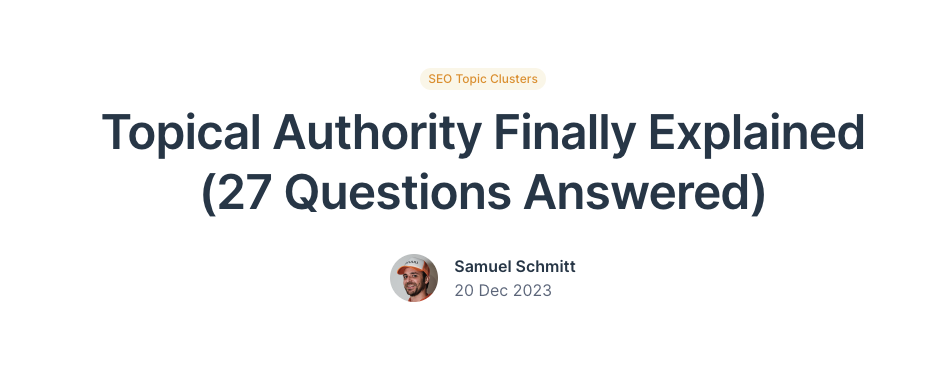
- Topical Authority Finally Explained (27 Questions Answered)
- Everything you want to know about AEM as a Cloud Service
- What is a Pillar Page?
Tool to create a FAQ Blog Post Template
With the thruuu content outline tool, you can generate easily FAQ Blog posts.
And as you can see below, the tool can even generate an answer snippet below each question.
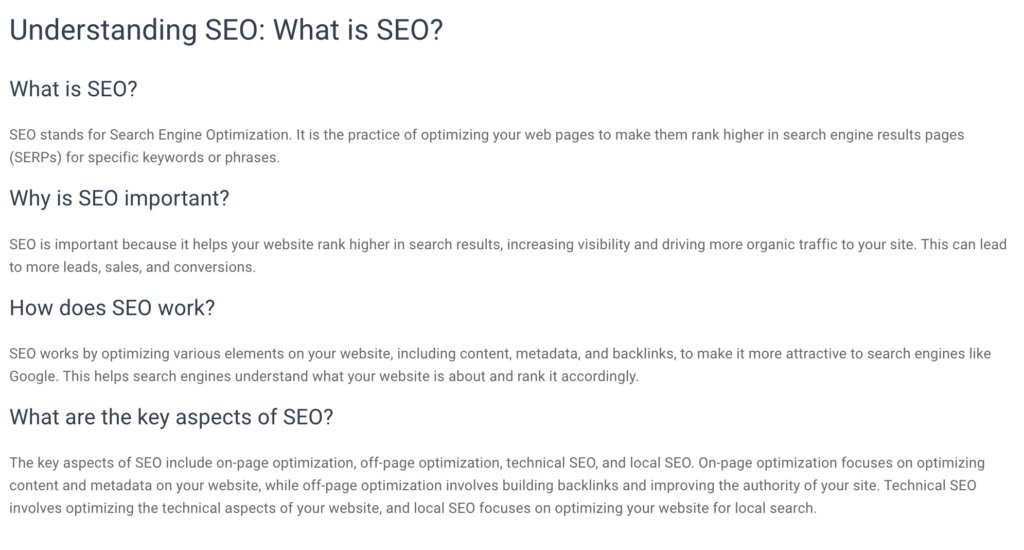
Tool to Create (any) SEO Blog Post Templates
In our article, we only listed the top SEO blog post templates, but we could have continued the list and included:
- Beginner’s guide blog post template
- Pillar blog post template
- Definition blog post template
- Expert roundup blog post template
- Infographic post template
- Step-by-step blog post template
- Cheat sheet blog post template
Also we could have shared blog post templates for specific niches or verticals, such as:
- Recipe blog post template
- Travel blog post template
Our point is that there is an infinite list of SEO blog post templates.
Based on your industry, you might need to create specific blog templates following a precise heading structure.
This is how thruuu can support you and create any blog post templates.
With the thruuu content brief tool, you can provide instructions (or prompts) to define the template of your blog post.
How does it work?
Enter your target keyword, and our tool will analyze your competitors and the template they follow for their blog posts.
Then, you can generate a structure for your article that will follow the instructions you provided.
Instructions are simple prompts that tell how to structure the outline and headings.
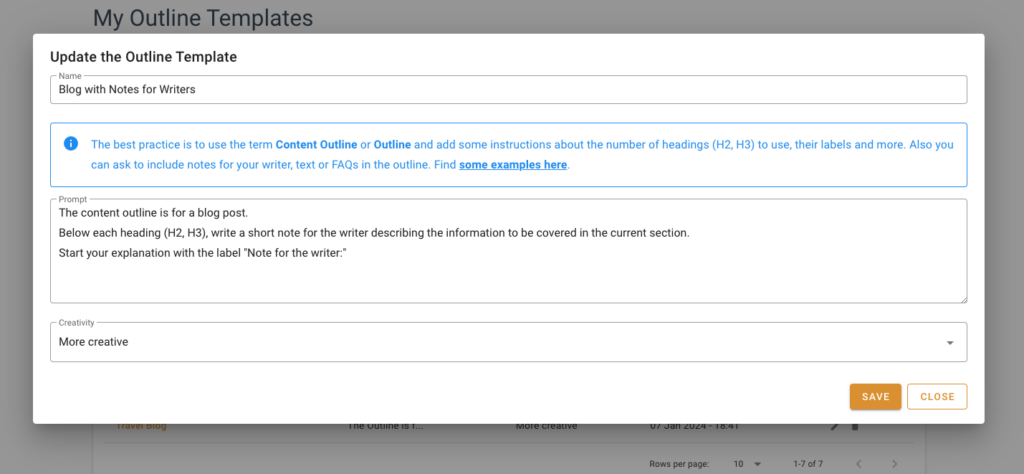
Follow this article if you want to learn how to create custom blog post template with thruuu.
Also, you can watch the video below where we show you step-by-step the process.
Final Words
All in all, having the appropriate tools and templates at your disposal would greatly improve the process of creating blog posts and raise your SEO results.
Using the SEO blog templates we’ve compiled, you can overcome writer’s block and regularly create engaging, search-engine-optimized material.
The process is further streamlined by the content outline automation tool from thruuu, saving you precious time and effort.
You can rapidly create well-structured outlines by evaluating the SERPs using its AI-based solutions and content brief generator, providing your blog articles a competitive advantage.
To establish a successful blog, remember that providing your readers with relevant and interesting information is essential.
Better SEO. Faster.
thruuu deciphers the Google algorithm for you and helps you build powerful content briefs in mere minutes.
